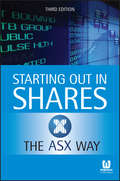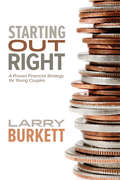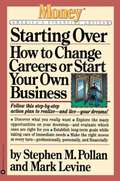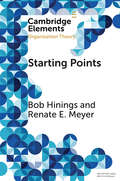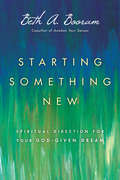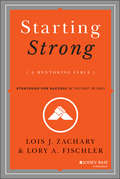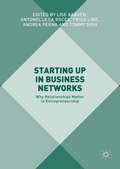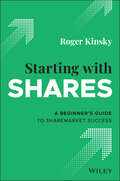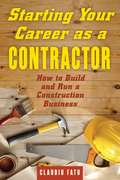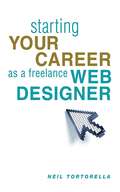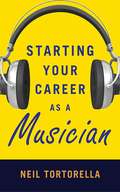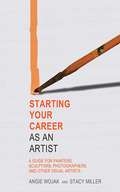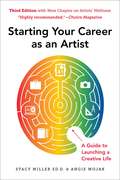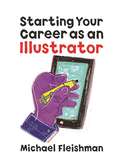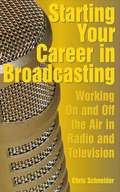- Table View
- List View
Starting Lean from Scratch: A Senior Leader’s Guide to Beginning and Steering an Organizational Culture Change for Continuous Improvement
by Brent Donald TimmermanWhat if the problem is you? For organizations just preparing to begin a continuous-improvement (CI) journey, the behaviors of the leadership must transform dramatically for the Lean toolkit to succeed. Many organizations invest in training colleagues about the power of the tools but fail to address the behavior and mindset of the leadership. Unfortunately, misaligned leadership behaviors will counteract any culture change that is attempted simply by pushing the use of Lean tools. This book outlines a comprehensive set of leadership principles that must be understood and modelled by the leadership before the CI Journey can effectively begin. This book organizes these leadership principles into a framework of a conceptual model called the "Three Spaces of Lean Transformation." The model suggests that these spaces of Trust, Change, and Continuous Improvement must be consciously shaped, developed, and maintained by the organizational leadership if a continuous improvement culture change succeeds. This book organizes a set of leadership principles -- that supports the culture change -- into each of these three spaces. The book is written in the first-person narrative and maintains a mentoring format. This book is for professionals at the very beginning of an intimidating Lean journey and with very little background or formal Lean training. Although these leadership principles are framed in the approach of being necessary to support an innovation culture change, the principles are, in fact, those necessary to support effective employee engagement. In addition, this set of leadership principles, if modeled consistently by the leaders, will create an organizational culture that will attract and retain great employees. These principles form the strong leadership foundation that must be established in organizations where, previously, many of the leadership behaviors were contrary to what is required by a "Lean" organization. The proper adoption of these leadership principles by an organization will support the long-term success of the Lean journey, and that this will enable a lasting, not a temporary, change to a continuous improvement culture.
Starting Out In Shares The Asx Way 3E
by AsxAn introduction to share investing--and whether it's right for youThe ASX investor education team has been providing the essentials about share investing for over 30 years. The latest edition of Starting Out in Shares the ASX Way is your one-stop resource to understanding what shares are--and how to buy and sell them. Inside, you'll have the pros and cons of shares over other investments explained. Many people don't know how the sharemarket actually works--the ASX team takes you through this. In easy to understand language, they will cover the process of investing including: effective ways to manage a portfolio, tried-and-tested stock selection methods, how to set yourself up for share investment, how to analyse shares and their prices and much more.If you want to explore the opportunities of share investing, you've come to the right place.Serves as a resource for those looking for more information before getting started in the sharemarketFully updated with the latest information for 2014A glossary of ASX sharemarket terms is provided at the back of the bookIf you're a would-be or beginner investor looking for trusted information on how to begin buying and selling shares on the Australian market, Starting Out in Shares the ASX Way will give you the confidence and knowledge you need to succeed.
Starting Out Right
by Larry BurkettIf you and your spouse are newly married, you probably have a lot of questions about how to make, spend, and invest money. Financial expert Larry Burkett can help you avoid the financial pitfalls many young couples encounter. In this highly practical guide, he helps you: * Understand how God uses money in a marriage, * Make wise choices about credit cards, * Design a budget that you both like, * Stop bad habits before they start, * Teach your children about finances, and * Decide what type of investments are right for you ... and much more.Starting Out Right offers solid biblical direction and time-tested advice to help you make wise financial choices that will last a lifetime.
Starting Over: How to Change Careers or Start Your Own Business
by Stephen M. Pollan Mark LevineThis invaluable guide offers a definitive game plan for anyone seeking to redefine his or her work status--for finding a new career or even starting a personal business.
Starting Points: Intellectual and Institutional Foundations of Organization Theory (Elements in Organization Theory)
by Bob Hinings Renate MeyerThis Element reviews the first 120 years of organization theory, examining its development from the sociology of organizations and management theory. It is initially organized around two streams of thought. The first is found in political economy and the sociology of organizations, with an emphasis on understanding the new organizations that arose in the late nineteenth and early twentieth centuries. The second derives from practitioner–scholars, whose aim was to provide theories and approaches to managing these new organizations. The Element then shows how each of the streams of understanding and managing came together to produce organization theory. In doing this, it also describes how the institutional frameworks in academic associations, academic centres and journals came out of these approaches and how they strengthened the development of organization theory.
Starting Right: A Basic Guide to Museum Planning
by Cindy Sherrell-Leo Gerald GeorgeThis easy-to-read guide provides information on all aspects of setting up a local museum.
Starting Strong
by Lois J. Zachary Lory A. FischlerA hands-on and usable guide to making the first 90 days of your mentoring relationship a successIn Starting Strong, mentoring experts Lois J. Zachary and Lory A. Fischler weave a compelling tale that exemplifies the concepts, highlights the dynamics, and outlines the issues involved in mentoring relationships. The authors use the form of a fable to tell the story of a budding mentoring relationship filled with possibilities, problems, and triumphs. The story of Cynthia, a seasoned professional, and her new mentee Rafa, brings to life Zachary and Fischler's wealth of mentoring suggestions and best practices and each episode of the fable is accompanied by reflection questions, key learnings, and strategies that readers can apply to their own mentoring relationships. The authors include a conversation playbook that guides mentors and mentees through six essential conversations that will help them establish a strong mentoring connection, and keep it moving forward.As organizations face the transition of departing Boomers and arriving Millennials, Starting Strong offers a hands-on and readable guide to create effective mentoring relationships that will ensure the success of that transition. The book:Covers the key components of a successful mentoring relationship including building trust, establishing a comfort zone (and then having the courage to leave it), holding productive meetings, dealing with power dynamics, setting goals, and keeping momentum goingShows how to avoid common pitfalls and overcome mentoring obstaclesApplies to any organizational or institutional settingStarting Strong is more than an engaging story of mentorship, it's a vital resource for understanding how to implement and sustain a meaningful mentoring relationship.
Starting Up in Business Networks
by Lise Aaboen Antonella La Rocca Frida Lind Andrea Perna Tommy ShihThis book offers a novel perspective on starting-up new business ventures through examining the process by which they become part of the existing business environment. The book highlights the importance of inter-organizational business relationships. Asserting that new ventures need to interact and connect with customers and suppliers, alongside policy actors and universities, Starting up in Business Networks demonstrates how beginning a new venture demands initiating and developing business relationships. Noting a lack of prior research into the process by which start-ups embed into an existing business network, this book presents examples from countries such as Sweden, Italy, the Netherlands and China to analyse the emergence and evolution of start-up business networks.
Starting With Shares: A Beginner's Guide to Sharemarket Success
by Roger KinskyYour no-nonsense guide to trading shares and succeeding on the share market Starting your share investing journey is easier than you might think. You don’t need a heap of capital, just a few basic rules and strategies. In Starting With Shares you’ll take your first steps toward building a profitable, sustainable portfolio. Written for beginners and packed with informative illustrations, straightforward tips and proven techniques, this essential guide will help you to become an effective and financially successful share investor. From Roger Kinsky, Australia's foremost share-investing educator and the best-selling author of Teach Yourself About Shares and Online Investing on the Australian Sharemarket, this guidebook will show you the simplest ways to make money from shares and protect your hard-earned dollars in the process! Unlike most sharemarket guides, this book explains in simple language all the stock market terms and definitions you need to know, with uncomplicated tips and straightforward strategies for earning returns. Learn how to get started and get ahead, buy and sell shares, build a portfolio, manage risk, deal with dividends and choose the best shares. Intimidated by jargon and unsure about where to start? Starting With Shares is a unique book that is shorter, simpler and more visual than other trading and investing resources, making it an excellent choice for you if you have little or no prior sharemarket knowledge. Learn to buy and sell shares from the best-selling author of Teach Yourself About Shares Start investing right away, even if you are an absolute novice with no knowledge of the markets Appreciate the simple, accessible explanations and informative illustrations of share investing basics Discover uncomplicated strategies that you can use for long-term investing success In Starting With Shares, you’ll not only learn how to start your share investing journey, but you’ll discover how to maximise your profitability into the future.
Starting Your Career as a Contractor: How to Build and Run a Construction Business (Starting Your Career)
by Claudiu FatuThis incisive, practical guide provides a thorough breakdown of the ins and outs everyone needs to know when turning contracting skills into a business. From summoning the motivation to start your own business to the intricacies of being your own boss, Claudiu Fatu artfully turns his personal experiences and those of other successful contractors into advice on every aspect of building a business. The chapters focus on: Developing a business structure, including bank accounts, tax registration, insurance, and branding Handling legal and accounting hurdles Managing employees and dealing with clients Using marketing systems to find and book work Estimating and bidding on jobs Writing contracts Creating invoices and a billing system Controlling costs, keeping records, and understanding profit margin Planning retirement and other benefits for the self-employed By teaching contractors to anticipate problems that can arise when dealing with clients, and to build a business plan that can support a contractor’s talents in the best way possible, Starting Your Career as a Contractor is the ultimate manual to getting the job done right!
Starting Your Career as a Dancer (Starting Your Career)
by Mande DagenaisIn Starting Your Career as a Dancer, author Mande Dagenais explains what it really takes to get into the business, be in the business, and survive in the business. Based on more than twenty-five years of experience in the performing arts as a dancer, teacher, choreographer/director, and producer, Dagenais offers insider advice and shares her vast knowledge while answering questions asked by professionals and beginners alike. Aspiring dancers will learn about different markets, venues, and types of work for dancers, and what to expect from a dancing job, while experienced dancers will appreciate helpful tips on where and how to find work, business management, and career transition. Covering topics ranging from audition dos and don'ts to injury prevention, this is absolutely the most comprehensive and practical guide you will find to the dancer's profession.
Starting Your Career as a Freelance Photographer: The Complete Marketing, Business, And Legal Guide (Starting Your Career)
by Tad Crawford Chuck DelaneyHere is a virtual treasury of advice, insight, and guidance for every freelance photographer! The step-by-step advice covers the multitude of concerns facing aspiring and beginning freelance photographers-from compiling a portfolio and promoting your work to winning the first client and running a healthy, profitable business. Esteemed attorney and writer Tad Crawford has teamed up with expert photography writer Chuck Delaney-and more than a dozen of the photo industry’s leading experts-to provide comprehensive guidance, including:Photographic careers and the skills they requireHow to shop for equipment and studio locationsClients, websites, portfolios, and self-promotionStudio management, insurance, and safetyNegotiating contracts, pricing, and model and property releasesCopyright law and protecting your workAvoiding libel, trespass, and litigationAccounting, record keeping, and taxesFor anyone looking to earn money with their photography, Starting Your Career as a Freelance Photographer crucial marketing, business, and legal know-how for every step of the process.Allworth Press, an imprint of Skyhorse Publishing, publishes a broad range of books on the visual and performing arts, with emphasis on the business of art. Our titles cover subjects such as graphic design, theater, branding, fine art, photography, interior design, writing, acting, film, how to start careers, business and legal forms, business practices, and more. While we don't aspire to publish a New York Times bestseller or a national bestseller, we are deeply committed to quality books that help creative professionals succeed and thrive. We often publish in areas overlooked by other publishers and welcome the author whose expertise can help our audience of readers.
Starting Your Career as a Freelance Photographer: The Complete Marketing, Business, and Legal Guide (Starting Your Career)
by Tad CrawfordHere is a virtual treasury of advice, insight, and guidance for every freelance photographer! From creating a portfolio and promoting your work to winning the first client and running a healthy, profitable business, Starting Your Career as a Freelance Photographer provides crucial marketing, business, and legal know-how for every step of the process. New entrepreneurs will discover in-depth information on choosing the right location, interacting with clients effectively, and receiving timely payments. They'll also find practical advice for keeping track of business income and expenses, managing insurance and tax issues, and marketing their work to a diverse range of clients.Readers will also find real-life answers to the essential questions every photographer asks, including how to negotiate, how to price, how to find the right market, and even how to keep from drowning in paperwork. Finally, the guide includes sample contracts, model release forms, and much more. For anyone looking to earn money with their photography, Starting Your Career as a Freelance Photographer is a must-have start-up kit!
Starting Your Career as a Freelance Web Designer (Starting Your Career)
by Neil TortorellaBreak out of the cubicle and gain the business savvy you need to launch your own freelance web design business with Starting Your Career as a Freelance Web Designer! Written by seasoned pro Neil Tortorella, this book guides web designers step-by-step down the path to success and helps them avoid common pitfalls. Jam-packed with practical know-how, this book also contains the wisdom and advice of noted industry authorities and business leaders. Readers will learn how to draft a solid business plan, negotiate contracts, manage time and money, deal with taxes, manage projects and clients, determine rates, and create winning proposals.
Starting Your Career as a Freelance Writer (Starting Your Career Ser.)
by Moira Allen“An essential read for freelance writers.” —The Writer magazineStarting Your Career as a Freelance Writer, Third Edition, offers a step-by-step guide to launching a successful freelance career. For beginners and experts, full time or part time, Moira Allen explains everything freelancer writers need to know, including how to set up a home office, develop and pitch marketable ideas, approach editors and other clients, and prepare and submit material. In addition, readers will learn the business side of freelancing, such as how to deal with rights and contracts as well as how to manage income, expenses, and taxes.Starting Your Career as a Freelance Writer also discusses the ways in which freelancer writers can expand and enhance their writing career. Allen gives essential advice on the use of photos and reprints and discusses how to take advantage of other writing opportunities, such as columns, business and technical writing, and even nonfiction books. Fully updated, this new edition includes:A fresh look at the top writing tools to get started in today’s Internet environmentThe best social media venues for writers and how to use themTips on how to expand a copywriting portfolio and clientele with social media writing servicesWhy a website is still the most important online marketing tool—and how to maximize its effectivenessHow a writer's blog can help your freelancing careerStarting Your Career as a Freelance Writer offers freelancers the tools and information they need to understand this business from the inside out and to become successful freelance writers.
Starting Your Career as a Musician (Starting Your Career)
by Neil TortorellaWhether you dream about becoming a rock star or a sought-after talent playing local gigs, Starting Your Career as a Musician will guide you along the path to success. Author Neil Tortorella explores the myriad opportunities in music today and details proven strategies for seeking them out. He reveals the common pitfalls and traps that are often encountered and provides aspiring musicians with time-tested advice on how to avoid them. Jam-packed with the practical know-how you need for success in the music business, Starting Your Career as a Musician is brought to life and made easy-to grasp through the wisdom and experiences shared by numerous working musicians. While it won't show you how to be a better musician, this indispensable guide will teach you how to make a living with your music, promote yourself or your band, get booked, and maximize additional revenue streams.
Starting Your Career as a Photo Stylist: A Comprehensive Guide to Photo Shoots, Marketing, Business, Fashion, Wardrobe, Off Figure, Product, Prop, Room Sets, and Food Styling (Starting Your Career)
by Susan Linnet CoxThis invaluable career manual explores the numerous directions a career in photo styling can take. Starting Your Career as a Photo Stylist prepares new and working stylists with in-depth information on food styling, fashion styling, and six other areas of specialization. Readers will also learn everything they need to know about practical aspects of the profession, including production, casting, location scouting, working with a photo crew, creating a portfolio, and marketing their work. Established stylists will benefit from tips on how to develop and sustain their freelance careers, and business forms will provide aspiring stylists with a head start on building their businesses. Interviews with working stylists offer insight into what it takes to thrive in their line of work. Written by a stylist with over twenty years of experience, Starting Your Career as a Photo Stylist is the ultimate guide to this little-known and exciting career!
Starting Your Career as an Artist: A Guide for Painters, Sculptors, Photographers, and Other Visual Artists (Starting Your Career)
by Stacy Miller Angie WojakStarting Your Career as an Artist is a comprehensive manual full of sound advice for artists seeking to advance their professional careers. Veteran art career professionals Angie Wojak and Stacy Miller show aspiring artists how to evaluate their goals, create a plan of action, and use their talents to build a productive life in the art world. Chapters cover topics essential to the emerging artist, such as building community through networking, collaborating, and finding mentors; setting up a studio; health and safety for artists; artist's resumes and CVs; developing marketing plans; finding alternative exhibition venues; and refining career aspirations. In addition, the book includes inspiring and insightful interviews with professional artists and well-known players in the art scene.http://www.facebook.com/StartArtCareer
Starting Your Career as an Artist: A Guide to Launching a Creative Life (Starting Your Career Ser.)
by Stacy Miller Angie WojakIn this comprehensive manual, veteran art career professionals Angie Wojak and Stacy Miller show aspiring artists how to evaluate their goals and create a plan of action to advance their professional careers, and use their talents to build productive lives in the art world. In addition, the book includes insightful interviews with professional artists and well-known players in the art scene. The second edition features a new chapter on social media and includes interviews with artists, museum professionals, and educators. All chapters cover topics essential to the emerging artist, such as: *Using social media to advance your practice *Health and safety for artists *Artist’s resumes and CVs *Finding alternative exhibition venues *Building community through networking *Collaborating and finding mentors *Refining career aspirations This invaluable resource is sure to encourage and inspire artists to create their own opportunities as they learn how the creativity that occurs inside the studio can be applied to developing a successful career in the art world.
Starting Your Career as an Artist: A Guide to Launching a Creative Life (Starting Your Career Ser.)
by Stacy Miller Angie WojakAn integral resource for aspiring artists, this third edition updates key pieces of the classic Starting Your Career as an Artist. In this comprehensive manual, veteran art career professionals Angie Wojak and Stacy Miller show aspiring artists how to evaluate their goals and create a plan of action to advance their professional careers, and use their talents to build productive lives in the art world. In addition, the book includes insightful interviews with professional artists and well-known players in the art scene. The third edition features a chapter on social media and includes interviews with artists, museum professionals, and educators, as well as new chapters on how to navigate the post-pandemic art world. All chapters cover topics essential to the emerging artist, such as: •Using social media to advance your practice •Health and safety for artists •Artist&’s resumes and CVs •Finding alternative exhibition venues •Building community through networking •Collaborating and finding mentors •Refining career aspirations This invaluable resource is sure to encourage and inspire artists to create their own opportunities as they learn how the creativity that occurs inside the studio can be applied to developing a successful career in the art world. Allworth Press, an imprint of Skyhorse Publishing, publishes a broad range of books on the visual and performing arts, with emphasis on the business of art. Our titles cover subjects such as graphic design, theater, branding, fine art, photography, interior design, writing, acting, film, how to start careers, business and legal forms, business practices, and more. While we don't aspire to publish a New York Times bestseller or a national bestseller, we are deeply committed to quality books that help creative professionals succeed and thrive. We often publish in areas overlooked by other publishers and welcome the author whose expertise can help our audience of readers.
Starting Your Career as an Illustrator: Revised Edition (Starting Your Career Ser.)
by Michael FleishmanFrom the first steps of starting out up through succeeding as a professional, Fleishman's newest guide navigates how illustration ties concept and technique. From advice on education and finding the right state of mind, through opening shop and finding the right venue, Starting Your Career as an Illustrator is a bit of a technical how-to, something of a business book, certainly an inspirational work, definitely a professional overview, even a personal lifestyle guide. It accurately documents the eclectic adventures of illustrators now, as well as relating historical perspectives, motivations, and inspirations to balance that picture and present readers with a true global field experience-all in an accessible, reader-friendly style. Topics include how to:Create a portfolioMake initial contactsDevelop a financial planSet up an officeAcquire supplies and equipmentPrice your own workMarket on the WebNurture a growing freelance businessAnd much moreThrough direct and candid conversations with scores of professionals up and down the career ladder, this book offers rich perspectives of illustrators (and their cohorts) at and away from the drawing board. It looks at the strong threads tying professional and academic process, practice, and product, and offers extensive research, a global pool of resources, and a wide panorama of info that promotes problem solving by way of a spectrum of ideas. Over fifty illustrations are included throughout.Allworth Press, an imprint of Skyhorse Publishing, publishes a broad range of books on the visual and performing arts, with emphasis on the business of art. Our titles cover subjects such as graphic design, theater, branding, fine art, photography, interior design, writing, acting, film, how to start careers, business and legal forms, business practices, and more. While we don't aspire to publish a New York Times bestseller or a national bestseller, we are deeply committed to quality books that help creative professionals succeed and thrive. We often publish in areas overlooked by other publishers and welcome the author whose expertise can help our audience of readers.
Starting Your Career as an Interior Designer
by Robert K. Hale Thomas L. Williams<p><i>Starting Your Career as an Interior Designer</i> contains all the necessary tools and strategies to successfully launch and grow a professional design business in the competitive world of interior design. Drawing on the authors' extensive experience, this book includes case studies, and personal anecdotes that help teach you how to: <p> <li>choose a design field <li>obtain and keep clients <li>garner referrals <li>market and position your business <li>bid competitively on projects <li>manage sales <li>organize a budget <li>manage start-up costs and cash flow <li>promote your business <li>branch out into product and architectural design <li>design within a retail environment <li>set pricing guidelines <li>sell to your target demographic <li>set up your office </li> <p> <p>Readers will find a history of the business side of interior design as well as various career tracks available to today’s budding entrepreneur. Any early career interior designer or student looking for practical advice on the ins and outs of running a design firm will need this one-stop guide.</p>
Starting Your Career as an Interior Designer (Starting Your Career Ser.)
by Robert K. Hale Thomas L. WilliamsStarting Your Career as an Interior Designer contains all the necessary tools and strategies to successfully launch and grow a professional design business in the competitive world of interior design. Drawing on the authors' extensive experience, this book includes case studies, and personal anecdotes that help teach you how to: Choose a design field Obtain and keep clients Garner referrals Market and position your business Bid competitively on projects Manage sales Organize a budget Manage start-up costs and cash flow Promote your business Branch out into product and architectural design Design within a retail environment Set pricing guidelines Sell to your target demographic Set up your officeReaders will find a history of the business side of interior design as well as various career tracks available to today’s budding entrepreneur. This updated second edition also examines the current state of the interior design industry, and what's in store for the future of firms. Any early career interior designer or student looking for practical advice on the ins and outs of running a design firm will need this one-stop guide.Allworth Press, an imprint of Skyhorse Publishing, publishes a broad range of books on the visual and performing arts, with emphasis on the business of art. Our titles cover subjects such as graphic design, theater, branding, fine art, photography, interior design, writing, acting, film, how to start careers, business and legal forms, business practices, and more. While we don't aspire to publish a New York Times bestseller or a national bestseller, we are deeply committed to quality books that help creative professionals succeed and thrive. We often publish in areas overlooked by other publishers and welcome the author whose expertise can help our audience of readers.
Starting Your Career in Broadcasting: Working On and Off the Air in Radio and Television (Starting Your Career)
by Chris SchneiderThis volume details how to begin or improve a career in broadcasting, with advice from many in the field, such as Bob Costas, Larry King, Jim Lampley, E. D. Hill, Rene Syler, station managers, and educators. Schneider relates how many stars got their start, and incorporates stories about their background and experiences throughout the book, from Walter Cronkite to Garrison Keillor.

